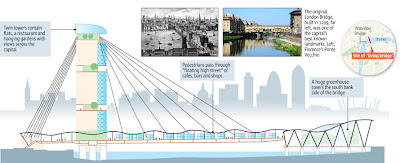The idea of habitable or living bridges keeps popping up in proposals, and the idea has a lot of merit in our desire to provide density, connectivity and ultimately, increased livability of urban areas. Another recent proposal uses the old/new idea in London to build a bridge including retail and residential uses and is being championed by Mayor Boris Johnson. As Treehugger mentions: “The Antoine Grumbach design has a pair of 35 storey towers holding up the bridge, which is lined with cafes, bars and shops, along with trees, a greenhouse and a “topiary café”.”

:: image via London Evening Standard
There is some historical precedent mentioned (particularly in reference to a popular nursery rhyme), particularly in the reference to the old London bridge: “London Bridge used to be a hopping place, lined with so many houses and shops that it took an hour to get across. So 178 years ago it was knocked down and replaced with a more sedate bridge, which was sold to an Arizona property developer who thought he was buying the iconic Tower Bridge.”

:: image via Treehugger

:: London Bridge – image via The Guardian
As Jonathan Glancey mentions in the Guardian, alongside this image (above) of historic London Bridge, “…inhabited bridges are alluring but impractical.” – mentioning traffic issues, as well as the aesthetic not fitting into the idea of our modern world – using two major precedents as examples. “As for surviving “inhabited” bridges, well, “tacky” is a polite word to describe the experience of crossing them. Florence’s Ponte Vecchio and Venice’s Rialto Bridge are exquisite structures, yet both are a kitsch nightmare today. The one thing both fail to do is to get people and goods across rivers in anything like a useful or enjoyable manner.”
Although the warnings may be viable, there is something intriguing about the idea of incorporating a variety of non-motorized uses into our spans. I sat in for studio crits for a University of Oregon architecture class taught by local architect Suzanne Zuniga that envisioned a range of opportunities from restaurants to swimming pools and skate parks linking east to west. Also, I posted about a speculative habitable bridge envisioned by local firm Path Architecture featuring similar retail environments. There is also the new Willamette River span – that while not incorporating commercial activity – is exclusive to light rail, bike and pedestrian crossing with a form that will become the newest addition to bridge city. Lots of potential, even without the shops.

:: image via Portland Architecture
The Galata Bridge in Istanbul is a great example of an inhabited bridge that actually works quite well.
see image here: http://en.wikipedia.org/wiki/File:Galata_bridge_2006_3.JPG
Thanks for the great tip on the Galata Bridge… I referenced it in an earlier post on Inhabited Bridges here.